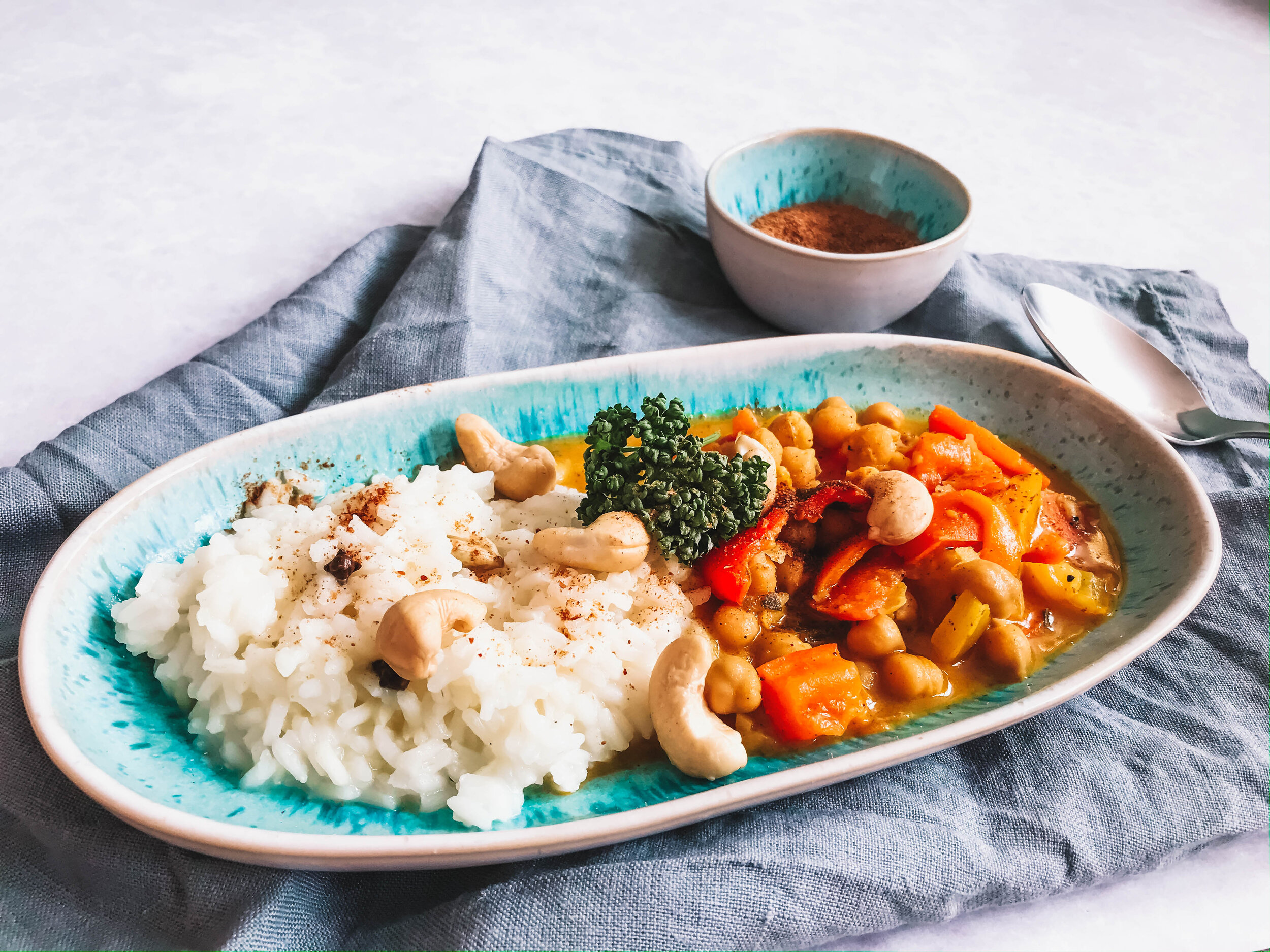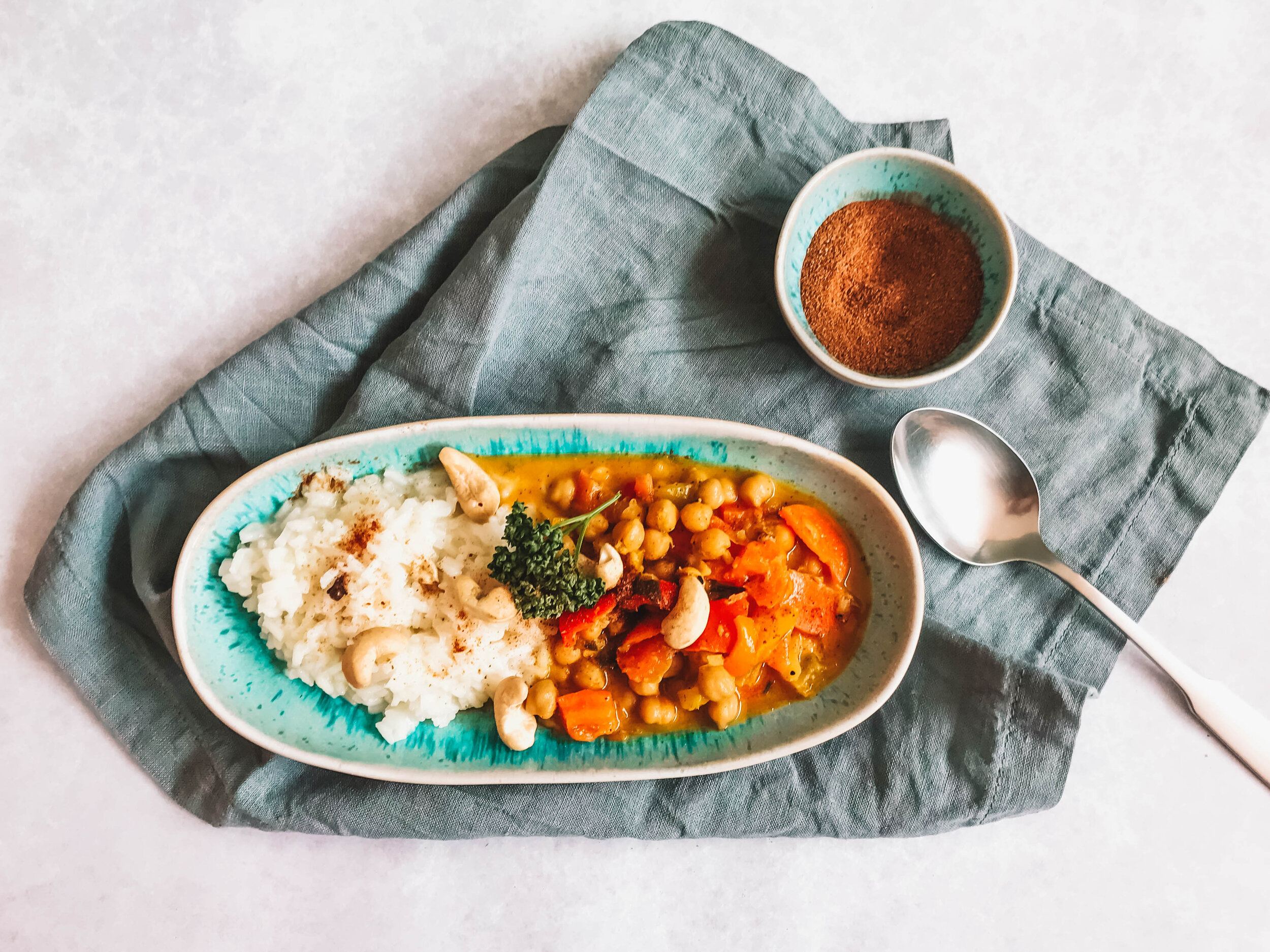Sweet Potato Chickpea Coconut Curry with Perfumed Basmati Rice and Garam Masala
Everyone loves meals that are fast and easy to make and healthy at the same time. Hands down, this dish fulfills all needs and it is my personal favorite curry of all times. It gives instant bliss and its aroma is divine – definitely a great comfort food.
To create this rich aroma and taste, the spices are an essential part. Trust me, once you stack up on all the spices, it is worth it! If you do not have all the spices at home, try with these only: fennel, black cumin, cilantro, asafoetida (hing), semi-sweet paprika powder, turmeric ginger, salt and pepper.
The spices help you with digesting this meal properly. They assist your digestive fire and create a balanced, ayurvedic meal with all six tastes, leaving your body satisfied with every bite.
This dish is perfectly balanced, with both augmenting and extractive ingredients. Nourishing and detoxing the system at the same time, without depleting it.
If you have a Kapha imbalance, you can use less of the coconut milk, but due to the spices, you should be fine. Rice and sweet potatoes are tri-doshic, balancing all three doshas. Chickpeas may aggravate Vata dosha, but I made sure that the spices counterbalance this effect. Therefore, everyone can eat this meal.
Let’s get started with what you will need, for approx. 4 portions:
This recipe makes about 2 big portions or and takes about 35 minutes to make.
INGREDIENTS
- 1 cup basmati rice
- 6 cardamom pods, whole
- 4 cloves, whole
- 1 yellow or red paprika or broccoli
- 2 sweet potatoes
- Bit of leek
- 3 tbsp ghee or coconut oil
- 400 ml coconut milk
- 1 tsp paprika powder, semi-sweet
- ¼ tsp fennel seeds, crushed
- ¼ tsp black cumin seeds, crushed
- ¼ tsp ajwain seeds, crushed (aka. wild celery seeds)
- ¼ tsp cumin powder (may omit)
- ¼ tsp cilantro seed powder
- ½ tsp fenugreek powder (may omit)
- knife ending of asafoetida (hing)
- ½ tsp turmeric powder
- 1 cm ginger, grated
- 1-2 tsp rock salt
- ½ tsp black pepper
- dash of lemon or lime juice
- optional toppings: roasted nuts, parsley, cilantro, Garam Masala…
INSTRUCTIONS
Wash and cut the veggies. Peel the sweet potato, cut in chunks and boil in a pot with water approximately 20 minutes (depending on the size of your chunks).
Meanwhile wash the basmati rice thoroughly. Melt 1 tbsp ghee (or coconut oil) and roast the rice in it for 1 minute. Add 1 ½ cups of water, whole cloves and cardamom pods to perfume the rice and let it simmer.
While it is simmering, roast the other veggies for two minutes in a pot in 1 tbsp ghee (or coconut oil) and add the coconut milk and the semisweet paprika powder and let it simmer. You can add the sweet potato now as well.
Preferably, you will use dry chickpeas (480g) for this recipe, as they contain prana. Soak the dry chickpeas (480 g) 24 hours (or less, depending on the quality of your chickpeas, the time differs) and cook them 1 ½ hours with lots of water or use a pressure cooker (approx. 25 minutes, but all pressure cookers are different, stay in the kitchen and read your manual first).
Alternatively, you can use two cans of chickpeas (240g each). But I do not recommend using canned food, as it has no prana, no life force. Usually, canned alimentation has been cooked years ago and is waiting a long time in the shelves, before you eat it.
Add the cooked chickpeas into the veggie mixture.
Then crush fennel, black cumin and ajwain seeds and add them into a pot with ghee.
Add cumin, cilantro and fenugreek powder, asafoetida (hing), turmeric and grated ginger. Roast them in ghee until the aroma arises and then add the spice mix to the coconut curry. Before serving add a dash of lemon juice, 1 tsp of rock salt and ½ tsp of black pepper.
To spice it up, you may want to serve the curry with Garam Masala, or with roasted nuts, parsley or cilantro on top.
Alternative:
You could use normal potatoes for this recipe, but the quality of this meal will not be the same. Normal potatoes may aggravate Vata dosha, while sweet potatoes are tri-doshic, meaning they will balance Vata, Pitta and Kapha.
In Ayurveda, we usually do not eat nightshades (such as tomatoes, potatoes, peppers, eggplant, mushrooms and paprika) as they have inflammatory qualities, are harder to digest and are of tamasic nature. I like using paprika, as it gives a certain flavor to dishes, cooked they are ok to use from time to time. Sweet potatoes and yam aren’t nightshades, but all types of peppers and paprika are.
Ayurveda suggests to eat everything in moderation as a medicine. Simply use nightshades in small quantities and enjoy a variety of different cooked vegetables. Whenever your body says yes or no to a vegetable or fruit, respect its innate wisdom and leave it out.
If you have health issues of any kind, please consider talking with your Ayurvedic consultant and follow a specific diet for you.
I hope you enjoy my favorite curry of all times, let me know how you liked it and make sure to tag me on social media so I can see your creation (@soulfoodbakery).
Much love,
Lisa


